Nero Burning Rom User Manual

Manual
Nero Burning ROM

Copyright and Trademark Information
This document and all its contents herein are subject to and protected by international copyright and other intellectual property rights and are the property of Nero AG and its subsidiaries, affiliates or licensors. All rights reserved. No part of this document may be reproduced, transmitted or transcribed without the express written permission of Nero AG. All trade names and trademarks and/or service marks are the property of their respective owners. The trademarks mentioned are expressly named for information purposes only. Nero AG rejects any claims that transcend the clauses of the guarantee rights to the fullest extent. Nero AG does not undertake any liability for the correctness of the content of this document. The contents of the software supplied, as well as of this document, may be changed without prior warning. Some applications of the Nero Suites require technologies developed by third-party manufacturers. Some of these are included as a trial version in this suite. These technologies need to be activated online (free of charge) or by sending an activation fax to have unlimited use of the version. Nero will then undertake to release the data necessary to activate technologies licensed by third-party manufacturers for unlimited use with Nero 12 or Nero 12 Platinum. It is therefore necessary to have an Internet connection or a fax machine. Unless you own the copyright or have permission from the copyright owner, you may be violating national or international copyright laws and be subject to payment of damages and other remedies, if you duplicate, reproduce, modify, or distribute copyrighted material. If you are unsure of your rights you should contact your legal advisor.
Copyright © 2012 Nero AG and its licensors. All rights reserved.
Nero, Nero BackItUp, Nero Burn, Nero Burning ROM, Nero CoverDesigner, Nero Digital, Nero Express, Nero Kwik Media, Nero Kwik Backup, Nero Kwik Blu-ray, Nero Kwik Burn, Nero Kwik DVD, Nero Kwik Faces, Nero Kwik MobileSync, Nero Kwik Move it, Nero Kwik Play, Nero Kwik Photobook, Nero Kwik Places, Nero Kwik Sync, Nero Kwik Themes, Nero Kwik Tuner, Nero MediaStreaming, Nero Recode, Nero RescueAgent, Nero SmartDetect, Nero Simply Enjoy, Nero SmoothPlay, Nero StartSmart, Nero SoundTrax, Nero Surround, Nero Video, Nero Video Express, Nero WaveEditor Burn-At-Once, LayerMagic, Liquid Media, SecurDisc, the SecurDisc logo, Superresolution and UltraBuffer are common law trademarks or registered trademarks of Nero AG.
Gracenote, CDDB, MusicID, MediaVOCS, the Gracenote logo and logotype, and the "Powered by Gracenote" logo are either registered trademarks or trademarks of Gracenote in the United States and/or other countries.
Manufactured under license from Dolby Laboratories. Dolby, Pro Logic, and the double-D symbol are registered trademarks of Dolby Laboratories, Inc. Confidential unpublished works. Copyright 2011 Dolby Laboratories. All rights reserved.
Manufactured under license under U.S. Patent Nos: 5,956,674; 5,974,380; 6,487,535 & other U.S. and worldwide patents issued & pending. DTS, the Symbol, & DTS and the Symbol together are registered trademarks & DTS Digital Surround, DTS 2.0+Digital Out and the DTS logos are trademarks of DTS, Inc. Product includes software. © DTS, Inc. All Rights Reserved.
Adobe, Acrobat, Reader, Premiere, AIR, and Flash are trademarks or registered trademarks of Adobe Systems, Incorporated. Apple, Apple TV, iTunes, iTunes Store, iPad, iPod, iPod touch, iPhone, Mac and QuickTime are trademarks of Apple Inc. registered in the U.S and other countries. AMD App Acceleration, AMD Athlon, AMD Opteron, AMD Sempron, AMD Turion, ATI Catalyst, ATI Radeon, ATI, Remote Wonder, and TV Wonder are trademarks or registered trademarks of Advanced Micro Devices, Inc. Bluetooth is a trademark owned by Bluetooth SIG, Inc. Blu-ray Disc, Blu-ray, Blu-ray 3D, BD-Live, BONUSVIEW, BDXL, AVCREC and the logos are trademarks of the Blu-ray Disc Association. Check Point is a registered trademark of Check Point Software Technologies Ltd. FaceVACS and Cognitec are either registered trademarks or trademarks of Cognitec Systems GmbH. DivX and DivX Certified are registered trademarks of DivX, Inc. DVB is a registered trademark of the DVB Project. 3GPP is a trademark of European Telecommunications Standards Institute (ETSI). Facebook is a registered trademark of Facebook, Inc. Google, Android and YouTube are trademarks of Google, Inc. LightScribe is a registered trademark of the Hewlett-Packard Development Company, L.P. Ask and Ask.com are registered trademarks of IAC Search & Media. IEEE is a registered trademark of The Institute of Electrical and Electronics Engineers, Inc. Intel, Intel Core, Intel Quick Sync Video, Intel XScale and Pentium are trademarks or registered trademarks of Intel Corporation in the U.S. and/or other countries. Philips is a registered trademark of Koninklijke Philips Electronics.N.V. Linux is a registered trademark of Linus Torvalds. InstallShield is a registered trademark of Macrovision Corporation. ActiveX, ActiveSync, Aero, Authenticode, DirectX, DirectShow, Internet Explorer, Microsoft, MSN, Outlook, Windows, Windows Mail, Windows Media, Windows Media Player, Windows Mobile, Windows.NET, Windows Server, Windows Vista, Windows XP, Windows 7, Windows 8, Xbox, Xbox 360, PowerPoint, Visual C++, Silverlight, the Silverlight Logo, the Windows Vista start button, and the Windows logo are trademarks or registered trademarks of Microsoft Corporation in the United States and other countries. My Space is a trademark of MySpace, Inc. NVIDIA, GeForce, ForceWare, and CUDA are trademarks or registered trademarks of NVIDIA. This program includes software developed by the OpenSSL Project for use in the OpenSSL Toolkit. (http://www.openssl.org/)\Open SSL is copyright © 1998-2005 The OpenSSL Project. All rights reserved. This program includes cryptographic software written by Eric Young (eay@cryptsoft.com). This program includes software written by Tim Hudson (tjh@cryptsoft.com). Cryptographic software inside Open SSL is copyright © 1995-1998 Eric Young (eay@cryptsoft.com). All rights reserved. CompactFlash is a registered trademark of SanDisk Corporation. Sony, Memory Stick, PlayStation, and PSP are trademarks or registered trademarks of Sony Corporation. AVCHD, AVCHD Lite and AVCHD Progressive are trademarks of Sony Corporation and Panasonic Corporation. HDV is a trademark of Sony Corporation and Victor Company of Japan, Limited (JVC). MP3 SURROUND, MP3PRO and their logos are trademarks of Thomson S.A. Unicode is a registered trademark of Unicode, Inc. The USB logo is a trademark of Universal Serial Bus Implementers Corporation. UPnP is a registered trademark of UPnP Implementers Corporation. Vimeo is a trademark of Vimeo, LLC. Yahoo! and Flickr are registered trademarks of Yahoo! Inc. Labelflash is a trademark of Yamaha Corporation
Other product and brand names may be trademarks of their respective owners and do not imply affiliation with, sponsorship, or endorsement by owners.
Nero AG reserves the right to change specifications without notice. Use of this product is subject to the acceptance of the End User License Agreement upon installation of the software. www.nero.com
Nero AG, Im Stoeckmaedle 18, 76307 Karlsbad, Germany
Nero Burning ROM |
2 |

Table of Contents
Table of Contents
1 |
Start Successfully |
6 |
1.1 |
About the Manual |
6 |
1.2 |
About Nero Burning ROM |
6 |
1.3 |
Versions of Nero Burning ROM |
7 |
1.4 |
Working With the Program |
7 |
1.5 |
Starting the Program |
8 |
1.6 |
System Requirements |
9 |
1.7 |
Supported Formats and Codecs |
9 |
1.7.1 |
Disc Types |
9 |
1.7.2 |
Disc Formats |
9 |
1.7.3 |
Audio Formats and Codecs |
10 |
1.7.4 |
Video Formats and Codecs |
10 |
1.7.5 |
Image Formats |
10 |
1.7.6 |
Formats for Playlists |
11 |
2 |
User Interface |
12 |
2.1 |
Main Screen |
12 |
2.2 |
New Compilation Window |
15 |
2.3 |
Selection Screen |
19 |
3 |
Data Disc |
22 |
3.1 |
Compiling Data Disc |
22 |
3.1.1 |
Defining Options |
24 |
3.1.1.1 |
Multisession Settings |
24 |
3.1.1.2 |
Autorun |
27 |
3.1.1.3 |
UDF Settings |
27 |
3.1.1.4 |
ISO Settings |
27 |
3.2 |
Compiling a SecurDisc disc |
29 |
3.3 |
Nero DiscSpan (UDF) Compilation and Nero DiscMerge Tool |
34 |
3.3.1 |
Set Nero DiscSpan Options |
34 |
3.3.2 |
Creating Multiple Discs with Nero DiscSpan |
35 |
3.3.3 |
Copy Data with Nero DiscMerge |
38 |
3.4 |
Check Point Media Encryption CD/DVD |
41 |
3.5 |
Saving Data Track |
42 |
4 |
Audio CD and Audio Files |
44 |
4.1 |
Compiling Audio CDs |
44 |
4.1.1 |
Customizing Properties of the Audio File |
46 |
4.1.1.1 |
Track Properties Tab |
46 |
Nero Burning ROM |
3 |

Table of Contents
4.1.1.2 |
Indexes, Limits, Split Tab |
48 |
4.1.1.3 |
Filters Tab |
50 |
4.1.2 |
Defining Options |
51 |
4.1.2.1 |
Audio CD Settings |
51 |
4.1.2.2 |
CDA Settings |
52 |
4.2 |
Mixed Mode CD and CD EXTRA |
54 |
4.2.1 |
CD-Extra Settings |
54 |
4.3 |
Automatic Music Recognition |
55 |
4.3.1 |
Identifying Audio Files |
56 |
4.4 |
Copy Audio CDs to Hard Drive |
57 |
4.4.1 |
Save Audio Tracks to Hard Drive Window |
60 |
4.4.1.1 |
Source Tab |
61 |
4.4.1.2 |
Output Tab |
62 |
4.5 |
Convert Audio File Format |
63 |
4.5.1 |
Encode Files Window |
64 |
4.5.2 |
AIFF and WAVE Encoding Options |
65 |
4.5.3 |
MP3 Lame Encoding Options |
66 |
4.5.4 |
MP3 and MP3PRO Encoding Options |
67 |
4.5.5 |
Nero AAC Encoding Options |
69 |
4.5.6 |
OGG Vorbis Encoding Options |
70 |
5 |
Video |
72 |
5.1 |
Compiling DVD-Video |
72 |
5.2 |
Compiling an AVCHD Video Disc |
73 |
5.3 |
Compiling a BDMV-Video Disc |
76 |
6 |
Bootable Disc |
79 |
6.1 |
Requirements for Booting From a Disc |
79 |
6.2 |
Bootable Disc Template |
79 |
6.3 |
Creating and Burning a Bootable Disc |
80 |
7 |
Loading Image File |
82 |
8 |
LightScribe |
85 |
8.1 |
Printing LightScribe Label |
85 |
8.2 |
CD Label Editor Window |
87 |
9 |
Labelflash |
89 |
9.1 |
Burn Label Window |
89 |
9.2 |
Printing Labelflash Labels and DiskT@2 |
90 |
10 |
Burn Compilation |
93 |
10.1 |
Choose Recorder Window |
93 |
Nero Burning ROM |
4 |

Table of Contents
10.2 |
Burn Settings |
95 |
10.3 |
Starting the Burn Process |
97 |
10.3.1 |
SecurDisc Surface Scan Results |
99 |
10.4 |
Burning With Image Recorder – Creating an Image File |
101 |
11 |
Copying a Disc |
103 |
11.1 |
Methods of Copying |
103 |
11.1.1 |
On-the-fly Copying |
103 |
11.1.2 |
Copy Over Image |
103 |
11.2 |
Copying Disc |
104 |
11.3 |
Copy Settings |
106 |
11.3.1 |
Image Settings |
108 |
11.3.2 |
Copy Options |
109 |
11.3.3 |
Read Options |
110 |
12 |
Erase Rewritable Disc Window |
113 |
13 |
About Nero SecurDisc Viewer |
115 |
13.1 |
Starting Nero SecurDisc Viewer |
115 |
13.2 |
Copying Data to Hard Drive |
116 |
13.3 |
Checking Data Integrity |
117 |
13.4 |
Checking Signature |
118 |
14 |
Nero MediaBrowser |
119 |
15 |
Configuration Options |
122 |
15.1 |
Compilation Settings |
123 |
15.2 |
Cache Settings |
124 |
15.3 |
Expert Features |
124 |
15.4 |
Ultrabuffer Settings |
125 |
15.5 |
LightScribe Settings |
126 |
16 |
Glossary |
127 |
17 |
Index |
131 |
18 |
Contact |
134 |
Nero Burning ROM |
5 |
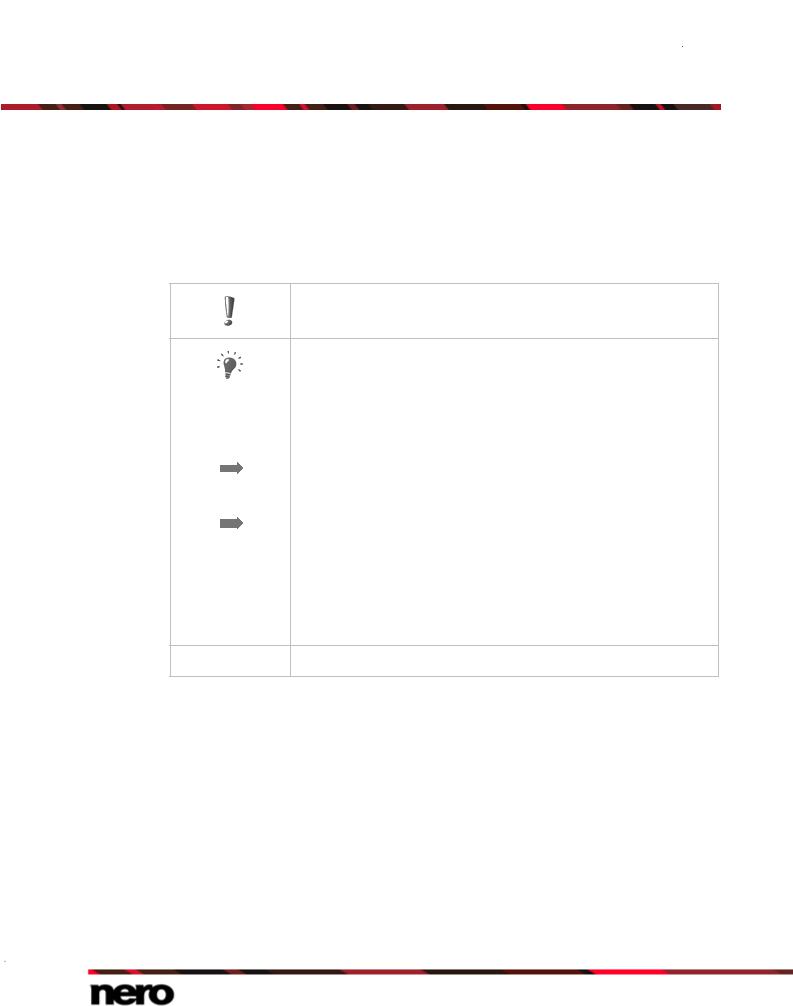
Start Successfully
1 Start Successfully
1.1About the Manual
This manual is intended for all users who want to learn how to use Nero Burning ROM. It is process-based and explains how to achieve a specific objective on a step-by-step basis.
To make best use of this documentation, please note the following conventions:
Indicates warnings, preconditions or instructions that have to be precisely followed.
|
Indicates additional information or advice. |
|
|
|
|
1. Start … |
The number at the beginning of a line indicates a prompt for action. |
|
Carry out these actions in the order specified. |
||
|
||
|
|
|
|
Indicates an intermediate result. |
|
|
|
|
|
Indicates a result. |
|
|
|
|
OK |
Indicates text passages or buttons that appear in the program |
|
interface. They are shown in boldface. |
||
|
||
|
|
|
(see…) |
Indicates references to other chapters. They are executed as links and |
|
are shown in red and underlined. |
||
|
[…]Indicates keyboard shortcuts for entering commands.
1.2About Nero Burning ROM
The powerful burning software Nero Burning ROM allows you to burn your data, music and videos to disc. Nero Burning ROM gives you full, customized control of your burning projects. You can − among other things − define the file system, the length of the file name and the character set; you can also change the disc label. And of course, you can also customize the Nero Burning ROM toolbar and change the keyboard shortcuts.
Despite its wide range of features, Nero Burning ROM has remained an easy-to-use burning program that creates discs in just a few steps. You select the disc type to be burned (CD/DVD/Blu-ray), define the project type, add the required data and then start burning.
Using Nero Burning ROM you can save audio files from an Audio CD to the hard drive. In the process, the files are encoded, i.e. converted into a format that the computer can read. The
Nero Burning ROM |
6 |
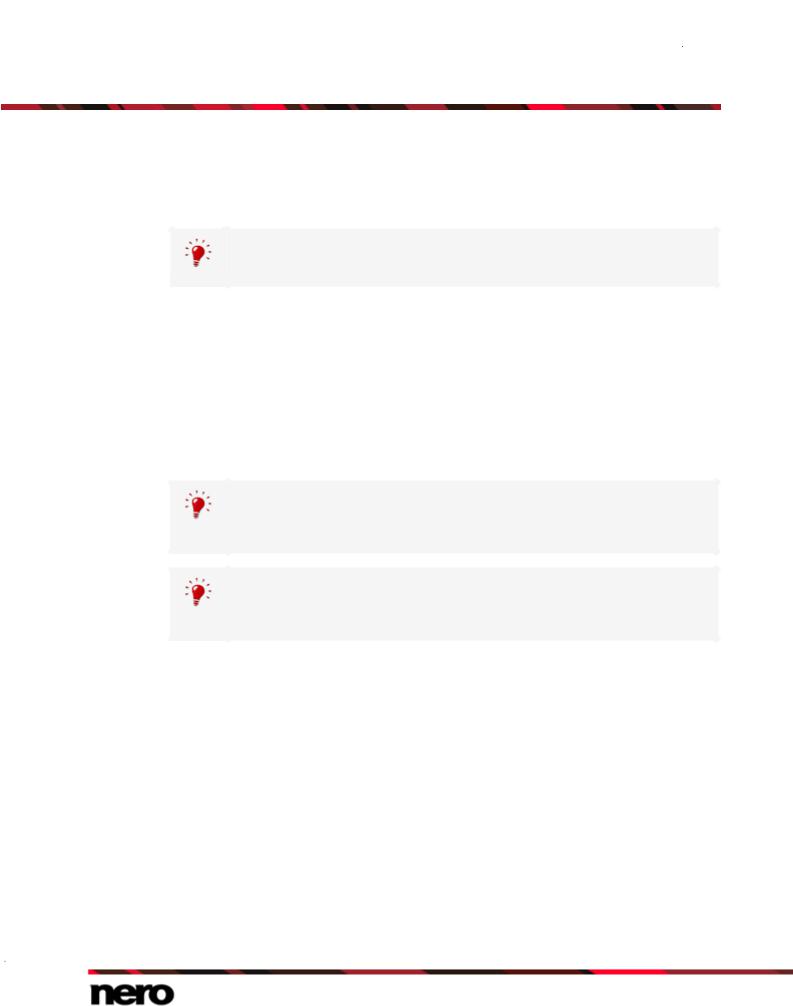
Start Successfully
Audio CD can be automatically identified with Gracenote. So called metadata such as title, genre, and track title are accessed by the Gracenote Media Database and associated to the tracks. That way you have audio files that are accurately and fully named after the encoding process.
Music recognition technology and related data are provided by Gracenote®.
Gracenote is the industry standard in music recognition technology and related content delivery. For more information, please visit www.gracenote.com.
1.3Versions of Nero Burning ROM
Nero Burning ROM is available as part of Nero 12, Nero 12 Platinum and as a standalone product (Nero Burning ROM 12).
All versions offer the full range of functions, but Nero Burning ROM as standalone product does not offer access to Nero MediaBrowser unless Nero Kwik Media is installed.
You can always upgrade your standalone version to Nero 12 or Nero 12 Platinum at www.nero.com.
Nero CoverDesigner is not installed automatically with Nero 12. However, it can be downloaded for free from the Download section at www.nero.com or via Nero ControlCenter and used together with Nero 12. Please see the separate Nero CoverDesigner user manual for full instructions.
Nero WaveEditor is not installed automatically with Nero 12. However, it can be downloaded for free from the Download section at www.nero.com or via Nero ControlCenter and used together with Nero 12. Please see the separate Nero WaveEditor user manual for full instructions.
1.4Working With the Program
The main function of Nero Burning ROM is to select files and folders and to burn them to a disc. This is done in three basic steps:
In the New Compilation window, select a disc type and the disc format and set the options on the tabs.
In the selection screen, select files that you want to burn.
Start the burn process.
See also
Main Screen →12
Compiling Data Disc →22
Compiling Audio CDs →44
Nero Burning ROM |
7 |
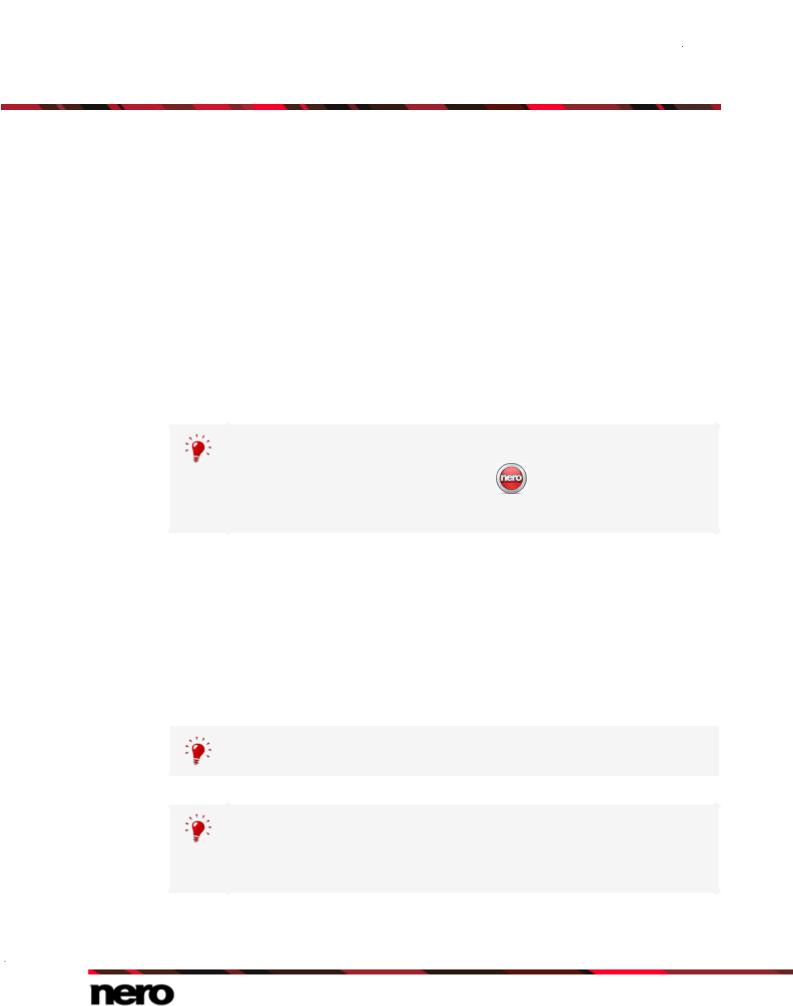
Start Successfully
Mixed Mode CD and CD EXTRA →54
Compiling DVD-Video →72
1.5Starting the Program
There are several ways to open Nero Burning ROM, depending on various factors such as the product you have installed and the operating system you are using.
On Windows 7 and earlier versions of Windows, you can start Nero Burning ROM via:
Start (the start icon) > (All) Programs > Nero > Nero 12 > Nero Burning ROM
the  Nero Burning ROM 12 desktop icon
Nero Burning ROM 12 desktop icon
the  Nero 12 Welcome Application if you use Nero 12
Nero 12 Welcome Application if you use Nero 12
The Welcome Application offers information about the main use cases and links to tutorials and other interesting Internet sites by Nero.
To start the Welcome Application, click the |
Nero 12 icon on your desktop |
(Windows 7 and earlier) or select the Nero 12 tile on the application selection screen (Windows 8).
On Windows 8, you can start Nero Burning ROM via:
the Nero 12 tile (Windows 8 style user interface) or the Nero 12 desktop icon (desktop user interface) if you use Nero 12
the Nero Burning ROM tile (Windows 8 style user interface) or the  Nero Burning ROM 12 desktop icon (desktop user interface) if you use Nero Burning ROM 12 as a standalone product
Nero Burning ROM 12 desktop icon (desktop user interface) if you use Nero Burning ROM 12 as a standalone product
It is also possible to start tasks with Nero Burning ROM from the context menu of a file or folder.
At first startup and if not disabled, the Welcome to Nero Burning ROM window is displayed. Here you will find information about the main use cases with Nero Burning ROM and links to tutorials and other interesting Internet sites by Nero. The window can be started at any time within Nero Burning ROM by clicking the
Get Started button.
Nero Burning ROM |
8 |
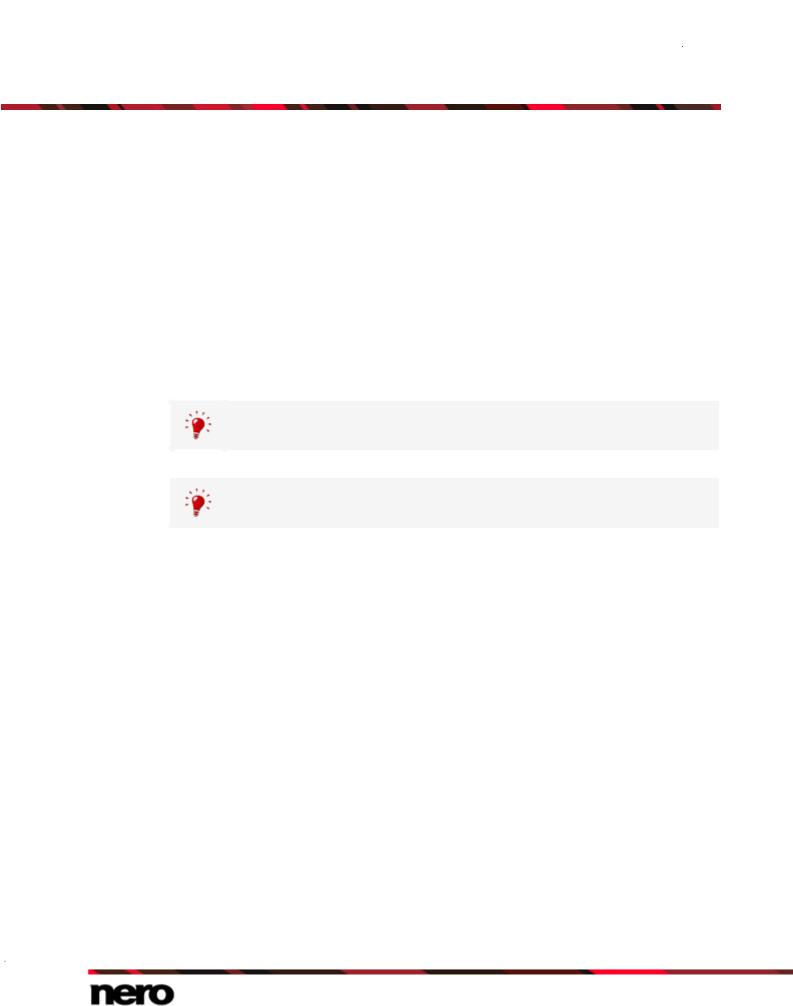
Start Successfully
1.6System Requirements
Nero Burning ROM is part of the Nero product you have installed. Its system requirements are the same. Detailed system requirements of this and all other Nero products can be found in the Support section on our Web site www.nero.com.
1.7Supported Formats and Codecs
1.7.1Disc Types
CD
DVD
Blu-ray - burning only
You can find more information on Blu-ray support at www.nero.com/link.php?topic_id=416.
The actual disc formats that are available and the actual disc types (e.g. DVD) to which can be written depend on the selected recorder.
1.7.2Disc Formats
Data CD (ISO, UDF, ISO/UDF)
Data DVD (ISO, UDF, ISO/UDF)
Blu-ray data disc (ISO)
SecurDisc CD/DVD/Blu-ray Disc
Audio CD
Mixed Mode CD
CD EXTRA
DVD-Video
Nero Image (NRG)
CUE-Image [Import only]
ISO-Image
AVCHD video
BDMV-Video
Nero DiscSpan (UDF)
Nero Burning ROM |
9 |

1.7.3Audio Formats and Codecs
AAC elementary stream (AAC) - not ripping
Audio Interchange File Format (AIFF, AIF)
Compact Disc Digital Audio (CDA) - not encoding
Dolby Digital (AC3) - only source format in compilations
MP3 / mp3PRO (MP3)
Nero AAC (MP4, M4A)
Ogg Vorbis (OGG, OGM)
PCM WAV file, ADPCM Wav file (WAV, WAVE)
Windows Media Audio (WMA) - not ripping
Free Lossless Audio Codec (FLAC)
1.7.4Video Formats and Codecs
Advanced Streaming Format (ASF)
Audio Video Interleave (AVI)
Digital Video (DV)
Moving Picture Experts Group-2 (MPG, MPEG, DAT, M2T)
Nero AAC Codec (MP4)
QuickTime Movie (MOV)
Video Object (VOB)
1.7.5Image Formats
Bitmap (BMP)
Device Independent Bitmaps (DIB)
Graphics Interchange Format (GIF)
Icon Image File (ICO)
JPEG File Interchange Format (JFIF)
Joint Photographic Expert Group (JPEG, JPG, JPE)
Picture Exchange (PCX)
Portable Network Graphics (PNG)
Portable Pixel Map (PPM)
Targa Image File (TGA)
Tagged Image File Format (TIFF, TIF)
Windows Media File (WMF)
Nero Burning ROM
Start Successfully
10

Start Successfully
1.7.6Formats for Playlists
Moving Picture Experts Group Audio Layer 3 Uniform Resource Locator/MP3 URL (M3U)
Moving Picture Experts Group Audio Layer 3 Uniform Resource Locator/MP3 URL + UTF-8 (M3U8)
Playlists File Format (PLS)
Nero Burning ROM |
11 |
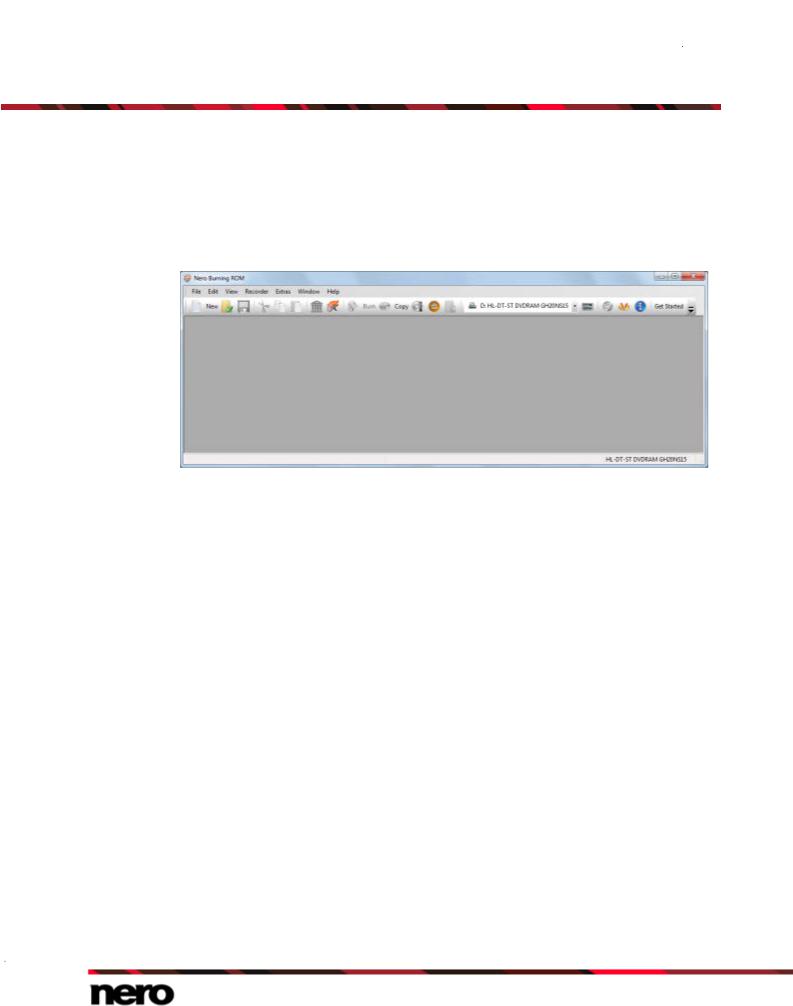
User Interface
2 User Interface
2.1Main Screen
The main screen of Nero Burning ROM is the starting point for all actions. It consists of a menu bar and a toolbar with buttons and a drop-down menu.
Main window with menu and toolbar
The following menus are available:
File |
Provides program facilities such as opening, saving, and closing. You can |
|
also open the setting options for the compilation, update the compilation, and |
||
|
define configuration options. |
|
|
|
|
Edit |
Provides editing facilities for the files in the selection screen such as cutting, |
|
copying, and deleting. You can also display the properties of a selected file. |
||
|
||
|
|
|
View |
Provides the option to customize the user interface and to refresh the file |
|
browser. |
||
|
||
|
|
|
Recorder |
Provides recorder facilities. You can select the recorder here, start the burn |
|
process, and erase a rewritable disc. You can also eject a disc and display |
||
|
disc information. |
|
|
|
|
Extras |
Provides the option to convert tracks into other formats and to save the songs |
|
on an Audio CD to the hard drive. |
||
|
||
|
|
|
Window |
Provides the option to alter the position of the compilation area and browser |
|
area. |
||
|
||
|
|
|
Help |
Provides help facilities such as opening the help, and shows information |
|
about the application. |
||
|
||
|
|
Nero Burning ROM |
12 |
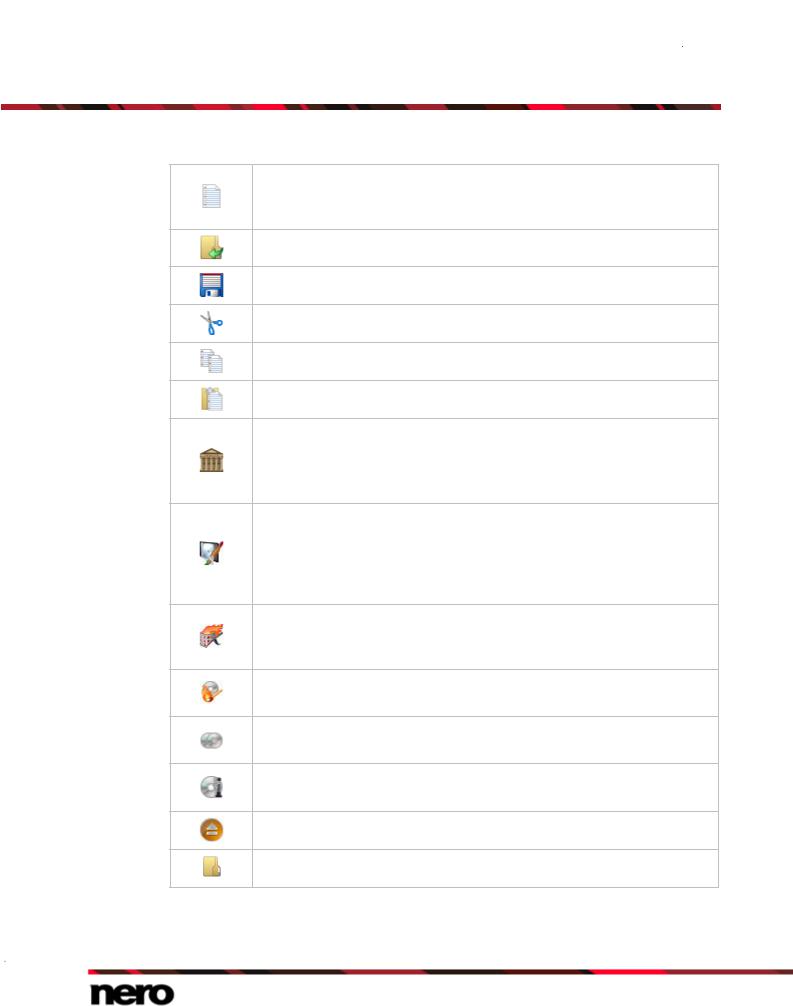
User Interface
The following configuration options are available in the tool bar of the main screen.
Opens the New Compilation window where you choose a compilation type and where you can set options for that compilation type as well as burning and copying.
Opens an existing compilation.
Saves the active compilation.
Cuts selected elements in the compilation (selection).
Copies selected elements of the compilation (selection).
Pastes a selection that was cut or copied beforehand.
Starts Nero MediaBrowser, which you can use to easily find, view and access media files and add them to your project.
Not available for video compilations (DVD-Video for example) as video structures are not supported by Nero MediaBrowser.
Starts Nero CoverDesigner, which you can use to create labels and covers. Information about a current compilation such as title, number, and names of the files is incorporated into the document data. You will find further information in the Nero CoverDesigner manual.
Only available if Nero CoverDesigner is installed.
Starts Nero Express. Nero Express is a wizard-driven application based on Nero Burning ROM. You will find further information in the Nero Express manual.
Starts the burn process by opening the Burn Compilation window containing the Burn tab.
Starts the copy process by opening the New Compilation window containing the Burn tab.
Displays information on the disc inserted, such as contents (if any) and capacity for instance.
Opens the selected drive.
Shows or hides the file browser.
Nero Burning ROM |
13 |

User Interface
Recorder
selection Displays available recorders. menu
Opens the Choose recorder window where you select an available recorder for the burn process from a list.
Opens the Burn Label window where you can create or load a label to print on the label or data side of a Labelflash DVD.
This button is only available if a recorder that supports Labelflash is connected.
Launches Nero CoverDesigner to create or load a label to be printed on the label side of a LightScribe disc.
This button is only available if Nero CoverDesigner is installed and if a recorder that supports LightScribe is connected.
Displays information on the program and version number.
Opens the Welcome to Nero Burning ROM window where you will find Get Started information about the main use cases and links to tutorials, the online help,
the Nero community and other interesting Internet sites by Nero.
Access to Nero MediaBrowser and Nero Express is only provided by Nero
Burning ROM as part of Nero 12.
With Nero CoverDesigner, you can create covers and labels for discs (CDs,
DVDs, etc.).
Nero CoverDesigner is not installed automatically with Nero 12. However, it can be downloaded for free from the Download section at www.nero.com or via Nero ControlCenter and installed together with Nero 12. You will find further information in the Nero CoverDesigner manual.
See also
New Compilation Window →15
Bootable Disc →79
LightScribe →85
Labelflash →89
Loading Image File →82
Erase Rewritable Disc Window →113
Configuration Options →122
Nero Burning ROM |
14 |
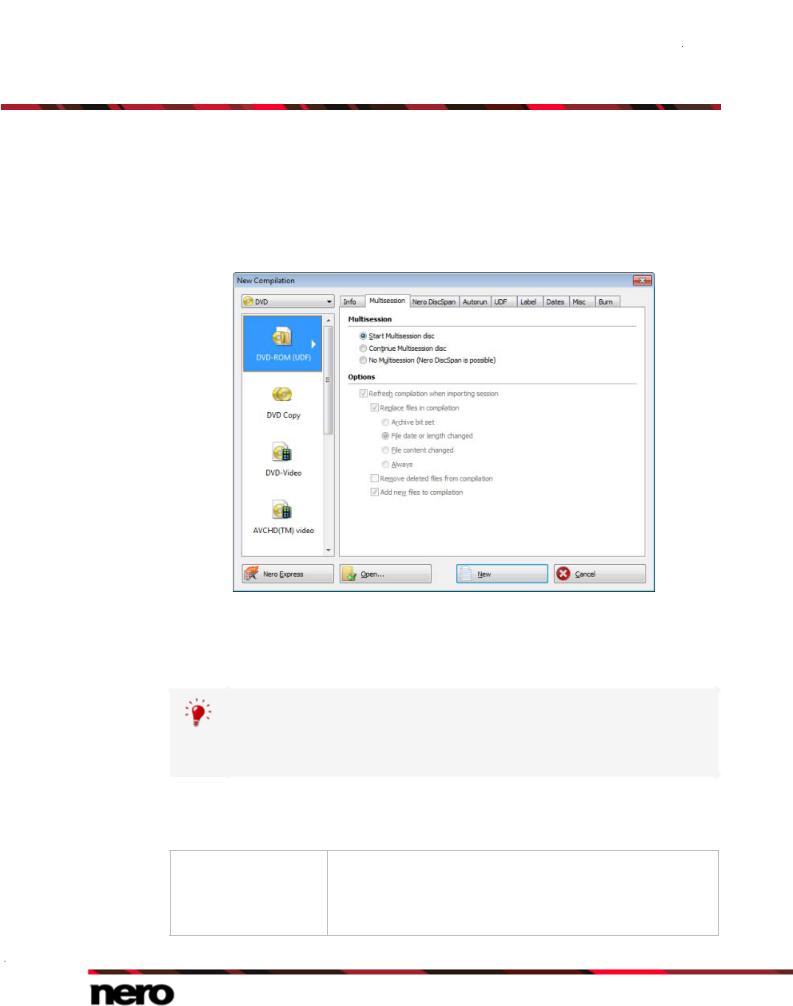
User Interface
2.2New Compilation Window
In the New Compilation window you can select the disc type and configure the options for the disc format. The window basically looks the same for all disc types. The only difference is the tabs that are available. When you start Nero Burning ROM, the New Compilation window opens automatically. If the window is not open, click the New button. The window consists of a drop-down menu, a selection list, various tabs, and buttons.
New Compilation window, CD-ROM disc type
If the Image Recorder is not enabled, only those disc types supported by the physical recorder are displayed in the drop-down menu. If the recorder can only burn CDs, the dropdown menu is grayed out.
Using Nero Burning ROM you can create image files for disc types that the installed recorder cannot burn. You can enable this function via the File >
Options > Expert Features menu, Enable all Nero supported disc types for the Image Recorder check box. The drop-down menu in the Compilation window then makes available all supported disc types.
The following entries are available in the selection list:
Entry
CD/DVD-ROM/Blu-ray
(UDF)
Creates a data disc; all file types can be burned. The burned data complies with the UDF standard.
Additionally you can use the Nero DiscSpan feature to comfortably burn a compilation on multiple discs.
Nero Burning ROM |
15 |

User Interface
Entry |
Creates a standard Audio CD that can be played on all (audio) |
|
Audio CD |
CD players at least. |
|
|
|
|
|
Creates a CD with data and audio files in a single session. |
|
Entry |
Usually a data file is followed by one or more audio files for |
|
instance (e.g. soundtrack for PC games). |
||
Mixed Mode CD |
||
Older Audio CD players are often not capable of recognizing the |
||
|
||
|
data file and attempt to play it. |
|
|
|
|
|
Creates a multisession CD with audio and data files that are |
|
Entry |
stored in two sessions. The first session contains the audio files |
|
and the second session the data. |
||
CD EXTRA |
Common CD players play the first session as Audio CDs. The |
|
|
second session can only be used by PCs with a CD-ROM drive, |
|
|
it cannot be recognized by a normal CD player. |
|
|
|
|
Entry |
|
|
CD/DVD/Blu-ray Disc |
Copies a source disc to a CD/DVD/Blu-ray Disc. |
|
Copy |
|
|
|
|
|
Entry |
Creates a bootable disc. |
|
CD/DVD-ROM (Boot) |
||
|
||
|
|
|
Entry |
Creates a data disc, each file type can be burned. The burned |
|
CD/DVD-ROM/Blu-ray |
||
data complies with the ISO 9660 standard. |
||
(ISO) |
|
|
|
|
|
Entry |
Creates a data disc; all file types can be burned. The burned |
|
CD/DVD-ROM |
||
data complies with the ISO and UDF standards. |
||
(UDF/ISO) |
||
|
||
|
|
|
Entry |
Creates a SecurDisc disc, that includes data integrity and |
|
reconstruction. Additional SecurDisc features include the |
||
CD/DVD-ROM/Blu-ray |
possibility to protect the data on your disc against unauthorized |
|
(SecurDisc) |
access with a password, to digitally sign the disc, and to |
|
|
configure the data redundancy. |
|
|
|
|
|
Creates a DVD that delivers high-quality playback of video |
|
Entry |
and/or picture files on DVD players. |
|
You can use Nero Burning ROM to burn a DVD if the DVD video |
||
DVD-Video |
||
title, i.e. a complete DVD folder structure including premastered |
||
|
||
|
files is already available. |
|
|
|
|
Entry |
Creates an AVCHD video disc that delivers high-quality playback |
|
of camcorder video and/or picture files on DVD or Blu-ray |
||
AVCHD (TM) video |
||
players. |
||
|
||
|
|
Nero Burning ROM |
16 |
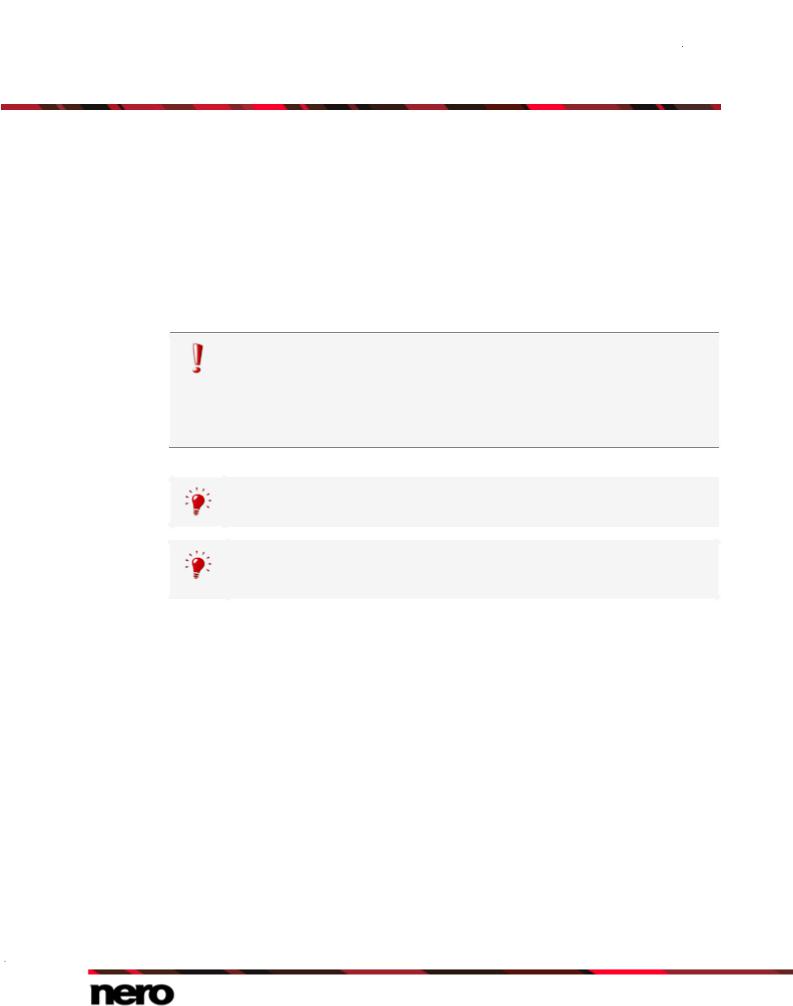
User Interface
|
|
You can use Nero Burning ROM to burn an AVCHD video disc if |
|
|
a complete AVCHD folder structure including premastered files |
|
|
is already available. |
|
|
|
|
|
Creates a Blu-ray Movie (BDMV) disc that delivers high-quality |
Entry |
|
playback of video files on Blu-ray players. |
|
You can use Nero Burning ROM to burn a BDMV-Video disc if a |
|
|
BDMV-Video |
|
|
complete BDMV folder structure including premastered files is |
|
|
|
|
|
|
already available. |
|
|
|
In Nero Burning ROM it is not possible to convert video files to DVD-Video, an AVCHD video, or a BDMV-Video. Converting video files to DVD-Video, to AVCHD video, or BDMV-Video is possible in Nero Video for example. Nero Video is included in the full version of Nero 12. More information about Nero Video is available on the Web site www.nero.com, and more information about video editing is available in the separate Nero Video manual.
The actual disc formats that are available and the actual disc types (e.g. DVD) to which can be written depend on the selected recorder.
A Jump List is provided by Nero Burning ROM under the Windows 7 operating system. Compilation types, e.g. Audio-CD, can be chosen directly from the Jump List.
The following buttons are available:
Button |
Starts Nero Express. Nero Express is a wizard-driven application |
|
based on Nero Burning ROM. |
||
Nero Express |
||
Only available in Nero Burning ROM as part of Nero 12. |
||
|
||
|
|
|
Button |
Opens a file browser where you can find and open a saved |
|
Open |
compilation. You can also open an image file in order to burn a disc. |
|
|
|
|
Button |
Creates the selected compilation and displays the selection screen |
|
New |
where you can select the files for burning. |
|
|
|
|
Button |
Closes the New Compilation window. |
|
Cancel |
||
|
||
|
|
You can set the options for the respective disc format on the tabs in the New Compilation window.
Nero Burning ROM |
17 |

User Interface
Which tabs are available depends on the disc type that is selected.
The following tabs are available:
Tab |
Shows statistical information on the compilation. |
|
Info |
||
|
||
|
|
|
Tab |
Contains options for starting and continuing multisession discs. |
|
Multisession |
||
|
||
|
|
|
Tab |
Contains the option for activating the Nero DiscSpan feature. This |
|
allows you to comfortably burn a compilation on multiple discs when |
||
Nero DiscSpan |
||
the data to be burned is too large to fit on a single disc. |
||
|
||
|
|
|
Tab |
Contains the option to select a file to be executed automatically |
|
Autorun |
when the disc is inserted into the disc drive. |
|
|
|
|
Tab |
Contains options for configuring the ISO file system. |
|
ISO |
||
|
||
|
|
|
Tab |
Contains options for configuring the UDF file system. |
|
UDF |
||
|
||
|
|
|
Tab |
Defines the labels of the disc. |
|
Label |
||
|
||
|
|
|
Tab |
Allows you to define the dates of the compilation and of the |
|
associated files. You can also specify a validity period for the disc. |
||
Dates |
||
You can access the data regardless of the validity period specified. |
||
|
||
|
|
|
|
Defines whether and which files are stored in the buffer memory. If |
|
|
you posses a Lightscribe recorder you can create the label here or |
|
Tab |
select what is to be printed. For the CD-ROM (ISO) disc type, you |
|
can convert the code for an AVI video here to make it compatible |
||
Misc |
||
with Xvid/MPEG -4 or DivX. |
||
|
We recommend that you only convert the code if you have |
|
|
experience with FourCC codes and AVI videos. |
|
|
|
|
Tab |
Contains options for configuring audio files. |
|
Audio CD |
You can also enter additional information about the CD. |
|
|
|
|
Tab |
Defines the strategy used by Nero Burning ROM for handling CD-DA |
|
CDA Options |
files from a source audio CD. |
|
|
|
Nero Burning ROM |
18 |
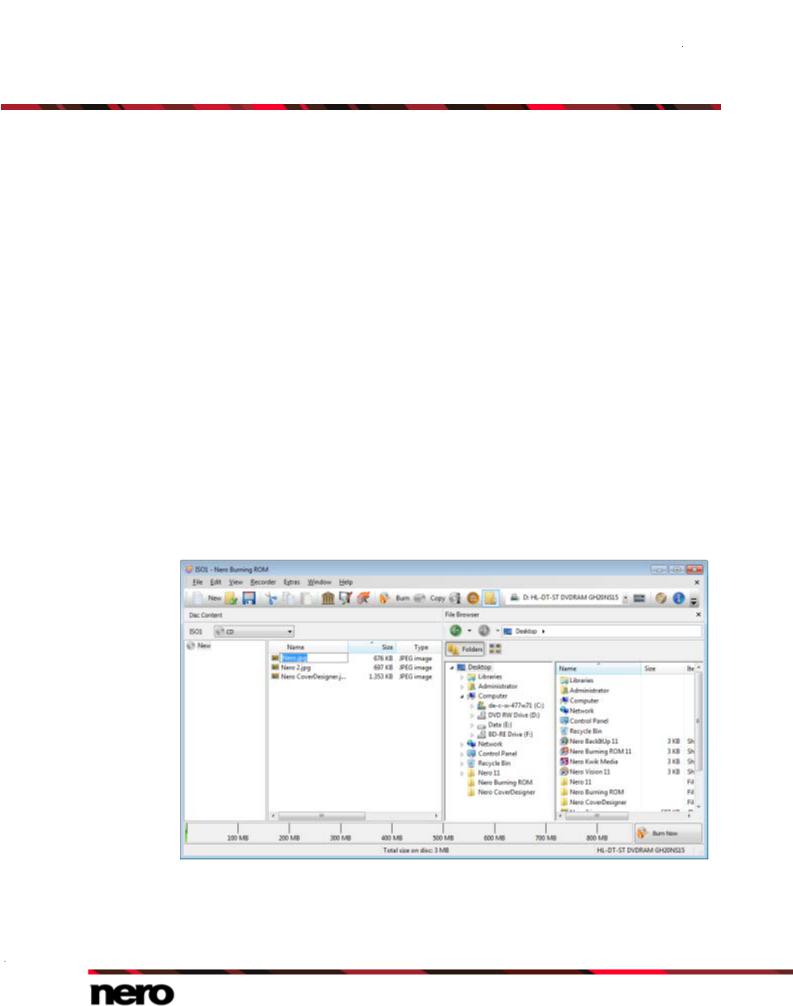
User Interface
Tab |
|
Contains options for configuring albums. |
|
CD EXTRA |
|
|
|
|
|
|
|
Tab |
|
Contains options for configuring a bootable disc. |
|
Boot |
|
|
|
|
|
|
|
Tab |
|
Contains options for configuring burning. |
|
Burn |
|
|
|
|
|
|
|
See also
Compiling Data Disc →22
Compiling Audio CDs →44
Mixed Mode CD and CD EXTRA →54
Compiling DVD-Video →72
2.3Selection Screen
The selection screen is displayed in the main screen after you select the disc type and format in the New Compilation window and click the New button. The selection screen consists mainly of the compilation area and the browser area. Essentially, all selection screens have the same structure.
Selection Screen
The compilation area (Disc Content) is located on the left side of the screen, and is named after the relevant compilation. Files and folders are compiled here for burning. In the browser area (File Browser) on the right side you can find the elements that you want to burn. You
Nero Burning ROM |
19 |
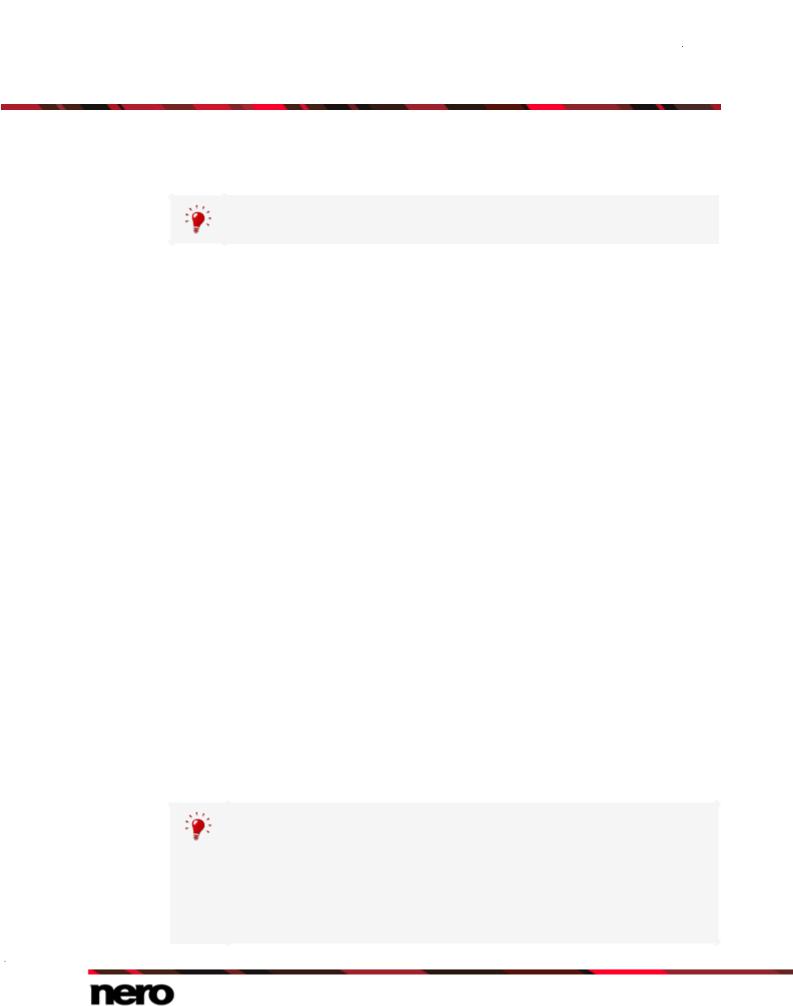
User Interface
can add data to your projects using the drag and drop function: Drag and drop the elements from the File Browser area to the Disc Content area.
If the File Browser area is hidden, you can show it again using the  button.
button.
The following setting options are available:
|
Allows you to select another disc type without loss of |
|
Disc type drop-down |
information. The option to change the disc type is useful when |
|
starting a compilation without knowing how much space is |
||
menu |
||
required by the files. |
||
|
||
|
Available for data compilations only. |
|
|
|
|
|
Allows you to expand or shrink the capacity bar according to |
|
Selection list |
the type of DVD you are going to burn. Choose the DVD9 (8.5 |
|
DVD9 (8.5 GB) / |
GB) option for a double layer DVD (DVD DL) and DVD5 (4.7 |
|
DVD5 (4.7 GB) |
GB) for a single layer DVD. |
|
|
Available for all DVD compilations. |
|
|
|
|
|
Allows you to expand or shrink the capacity bar according to |
|
Selection list |
the type of Blu-ray Disc you are going to burn: |
|
BD QL (BDXL) (128 GB) for a quadruple layer Blu-ray Disc, |
||
BD QL (BDXL) (128 GB) / |
||
BD TL (BDXL) (100 GB) for a triple layer Blu-ray Disc, |
||
BD TL (BDXL) (100 GB) |
BD DL (50 GB) for a double layer Blu-ray Disc (BD DL) and |
|
BD DL (50 GB) / |
||
BD (25 GB) for a single layer Blu-ray Disc. |
||
BD (25 GB) |
||
Available for all Blu-ray Disc compilations except BDMV- |
||
|
||
|
Video. |
|
|
|
|
Button |
Starts the burn process immediately. If you want to check or |
|
select the burn or compilation options again before burning, |
||
Burn Now |
||
click the Burn button in the upper part of the screen. |
||
|
||
|
|
The bottom margin of the screen contains a capacity scale in MB or GB for data discs or minutes (min) for Audio CDs. The exact size of the scale will depend on which disc type you have selected.
Actual capacity of media formats
The actual capacity of the DVD5, DVD9, BD DL, and BDXL media formats is less than as stated by the disc manufacturers. For example, the actual capacity of a 4.7 GB DVD5 is around 4.38 GB only.
This is because of different conversion systems. A DVD5-media format can handle 4.700.000.000 bytes, but this number is not equal to the 4.7 GB stated by the disc manufacturers. The correct conversion factor for bytes is not 1000, but 1024:
Nero Burning ROM |
20 |
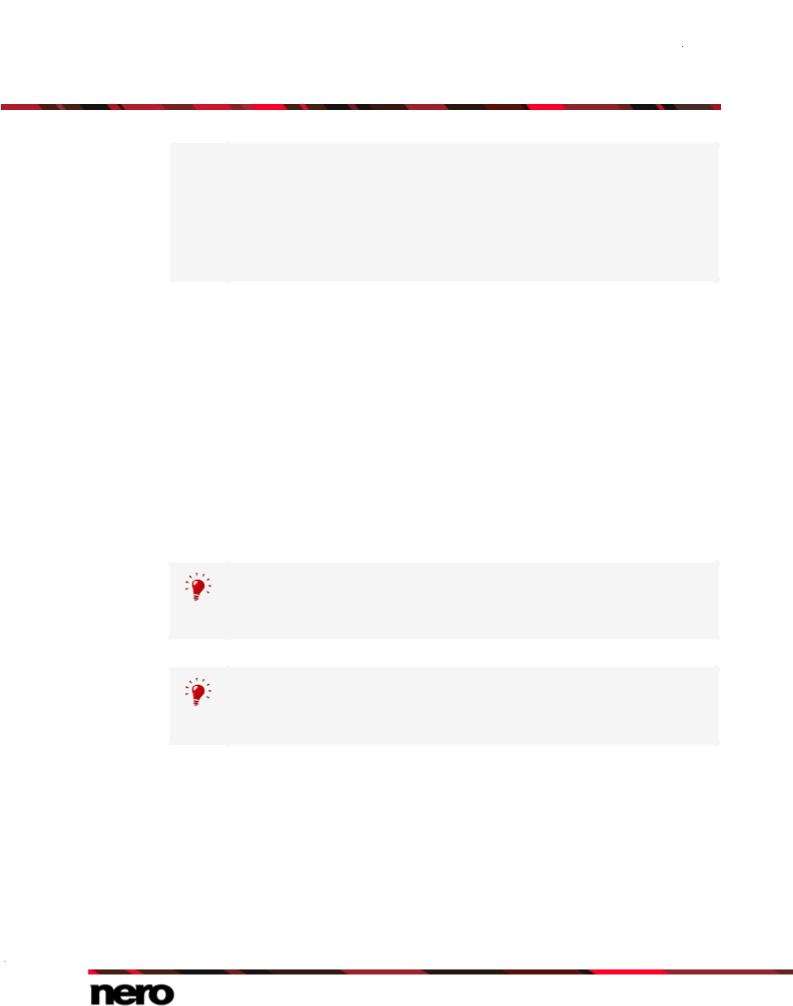
User Interface
1024 byte = 1 KB
1024 KB * 1024 KB = 1 MB
1024 KB * 1024 KB * 1024 KB = 1 GB A DVD can handle 4.700.000.000 bytes:
4.700.000.000 bytes = 4.589.843 KB = 4.482 MB = 4.377 GB
The capacity bar in Nero Burning ROM will always show you the correct amount of bytes measured in MB or GB.
When you are compiling files, a capacity bar shows you the estimated size of the selected files and the available space on the disc. The color of the capacity bar indicates whether the data will fit on the disc or not:
Green capacity bar |
The data will fit on the disc. |
|
|
|
|
Yellow capacity bar |
The data might fit on the disc. The size of the disc that has been |
|
inserted will determine whether the data will fit or not. |
||
|
||
|
|
|
Red capacity bar |
The data will not fit on the disc. |
|
(Unless you have inserted an oversize disc.) |
||
|
||
|
|
The yellow and red marks are set by default for discs that are commercially available. The disc type you have selected will determine the exact scale value.
Capacity of the CD recordable disc
For example, blank CDs are available with a capacity of 650 MB (74 min) or 700 MB (80 min). Therefore, the yellow mark is set for CDs at 650 MB and the red at 700 MB.
Display the Capacity Bar
If the capacity scale is hidden you can display it again by clicking the File > Options > Compilation menu and by selecting the check box Show the compilation size in the Nero status bar.
Nero Burning ROM |
21 |
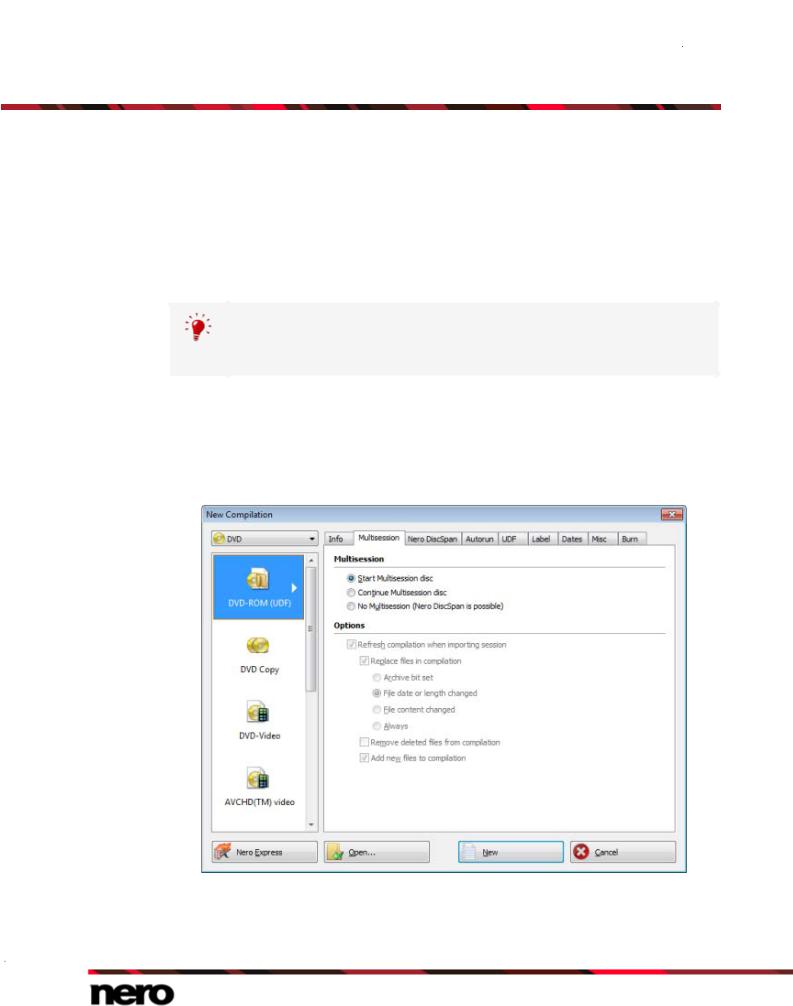
Data Disc
3 Data Disc
3.1Compiling Data Disc
With Nero Burning ROM you can compile and burn all types of files and folders. If a Blu-ray recorder is installed on your computer you can burn data CDs, data DVDs and data Blu-ray Discs. If you have a CD recorder you can only burn data CDs. The procedure for all data compilation methods is identical.
The Image Recorder is also suitable for creating an image of a disc type not supported by the connected recorder. For example, you can therefore create a DVD image without having installed a DVD recorder. You can then write the image to a disc at any time.
To create a data disc, proceed as follows:
1.Select the desired disc format (CD, DVD, Blu-ray) from the drop-down menu in the New
Compilation window. (In the case that the New Compilation window is not opened, it can be opened by clicking the New button on the main screen.)
The selection list shows the compilation types that can be burned.
New Compilation Window
Nero Burning ROM |
22 |
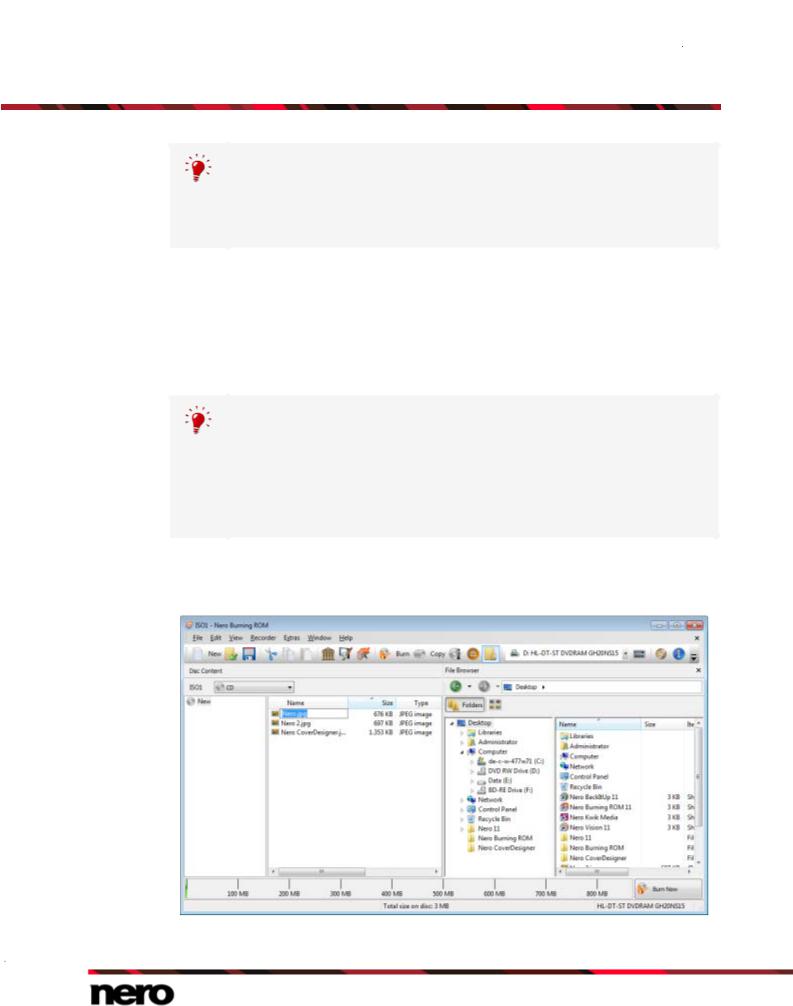
Data Disc
You can select an appropriate disc format without loss of information at any time in the main screen. Note that this has to be technically possible - for example you are obliged to burn an Audio CD to a CD. But it is possible to start with a data CD and change later to a data DVD, for example. The possibility to change the disc type is useful when starting a compilation without knowing how much space is required by the files.
2.Select the desired compilation type for a data disc from the selection list (CD/DVD-ROM/
Blu-ray Disc (UDF) , CD/DVD-ROM/Blu-ray Disc (ISO), or CD/DVD-ROM/Blu-ray Disc (UDF/ISO).
The tabs with the configuration options that are valid for this compilation type are displayed.
3.Set the options you require on the tabs.
Enabling Nero DiscSpan is useful, if the file size of the data to be burned is larger than the disc size or if you do not know exactly whether the files fit on one disc. With Nero DiscSpan the files are burned to several discs if necessary. Nero DiscSpan is only available for UDF-compilations.
Enabling Multisession is useful, if the file size of the data to be burned is much smaller than the disc size or if you are not sure, if your compilation is complete yet. With Multisession, you can burn additional content later on.
Note, that you can either enable Nero DiscSpan or enable Multisession.
4.Click the New button.
The New Compilation window is closed and the selection screen is displayed.
Compilation screen
Nero Burning ROM |
23 |
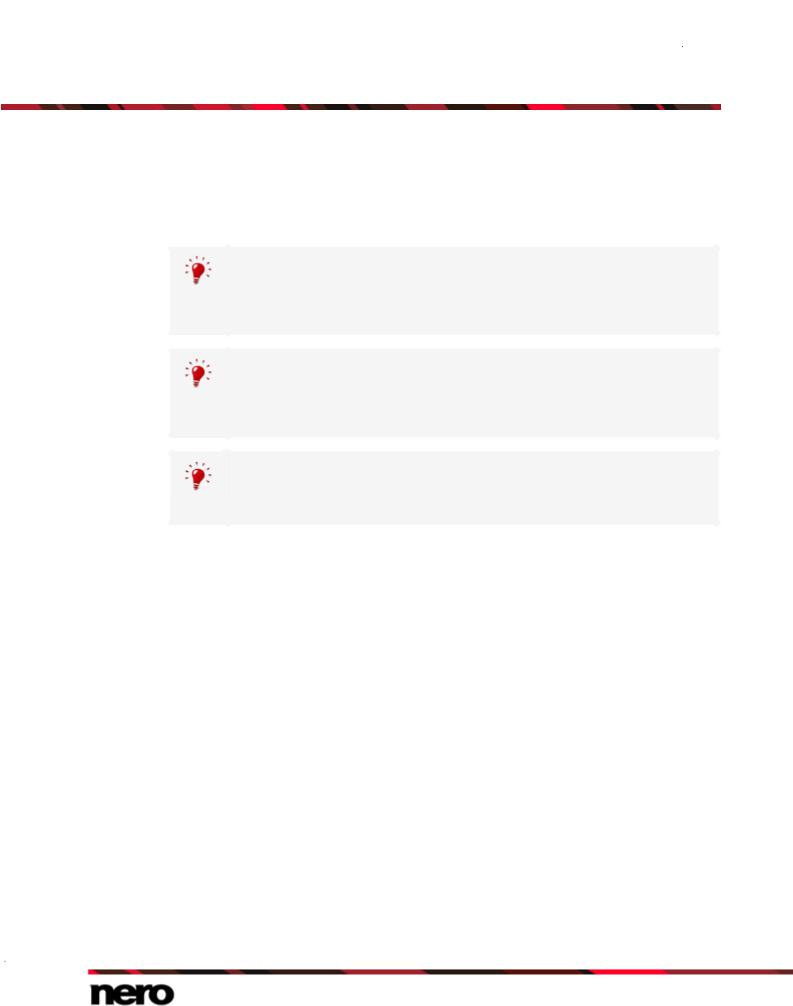
Data Disc
5.Select the files/folders that you want to burn from the File Browser area.
6.Drag the required files/folders into the Disc Content area on the left side.
The files are added to the compilation and displayed in the compilation screen. The capacity bar indicates how much space is required on the disc.
In Nero Burning ROM, there is the option of defining filters for individual files or folders by dragging files or folders into the compilation areas with the depressed right mouse button. For instance, it is possible to filter for a particular type of file (*.doc, *.xls, *.txt) or select which type of file is not to be taken up in the compilation area.
It is very easy to hide files in data compilations for additional protection or for security reasons so that they do not appear on the normal display. The files behave in the same way as other hidden system files that are hidden by default, but can easily be displayed. To hide files, right-click the required file, select the Properties option and then select the Hide check box.
Nero Burning ROM supports virtual search folders in the Windows Vista operating system. The search is selected by dragging the search folder into the compilation area. If you want to select the files of the search folder, you must open the search folder and drag the files into the compilation.
7.Repeat the previous step for all files that you want to add.
You have successfully compiled a data disc and can now burn this compilation.
See also
Selection Screen →19
3.1.1Defining Options
3.1.1.1 Multisession Settings
The Multisession tab provides the option to create multisession discs for data discs. Multisession discs can be burned in multiple sessions until you have reached the maximum disc capacity. A session is a self-contained data area that is burned using a single process, and consists of a lead-in (with the table of contents), one or more tracks, and a lead-out. Discs without the multisession option, e.g. Audio CDs, are burned in a single session.
If a new multisession disc is being started, Nero Burning ROM also saves (if possible) the point of origin for the files. This information is used when continuing the multisession disc.
If a multisession disc is being continued, Nero Burning ROM automatically sets a cross reference to the imported session, i.e. the table of contents for the imported session is copied to the table of contents for the current session. You must define which session is being imported when starting your compilation. The files in the previous sessions are retained and continue to take up space. Nero Burning ROM automatically verifies whether
Nero Burning ROM |
24 |
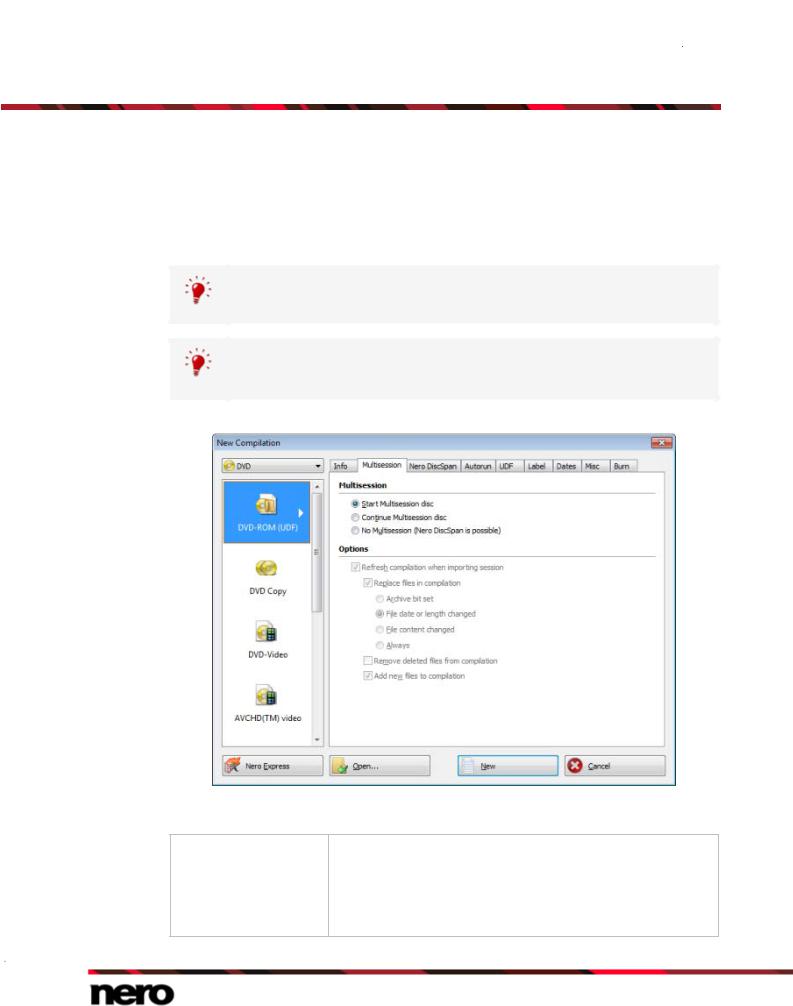
Data Disc
the correct multisession disc has been inserted for continuation. If not, the disc is ejected.
You can add new files to the compilation or delete files from the compilation when you continue the multisession disc. Files and folders from the session to be continued can even be refreshed, that means, changes in the folders like updated or deleted files can be taken over to the compilation. In any case, after the burn process the disc gives you access to exactly these files and folders that were visible in the compilation in Nero Burning ROM.
If you disable the Finalize disc check box on the Burn tab, you can always burn additional sessions on the disc, but then only the last session will be visible and you will only be able to access data from the last session.
Multisession disc
Multisession discs are particularly suitable for backing up important files burned on a regular basis.
Multisession Tab
The following option buttons are available on the Multisession tab in the Multisession area:
Burns the selected compilation in one session to the disc.
If the disc already contains sessions, you can also select this Start Multisession disc option. Sessions are then not imported and cross references are
not set. This means that only the last session will be visible and you will only be able to access data from the last session.
Nero Burning ROM |
25 |

Data Disc
|
Continues a multisession disc by burning an additional session |
|
|
to a disc with at least one session. Cross references to the |
|
|
imported session are set in the process. |
|
Continue Multisession |
When you select this option, the multisession disc must be |
|
disc |
inserted in a drive. You then have to define which session is |
|
being continued. The compilation screen will show the visible |
||
|
||
|
files and folders on the multisession disc, but grayed out. |
|
|
Everything you see in the compilation screen will be accessible |
|
|
on the disc later on. |
|
|
|
|
|
Creates a disc without a multisession. |
|
|
However, even a disc without a multisession can be continued |
|
No Multisession |
as long as it is not finalized. Sessions are then not imported and |
|
cross references are not set. This means that only the last |
||
|
||
|
session will be visible and you will only be able to access data |
|
|
from the last session. |
|
|
|
When selecting the Continue Multisession disc option button, the Options area is available with the following check boxes:
|
Gives you the possibility to refresh your compilation (and |
|
|
therefore the accessible files on the multisession disc after |
|
Refresh compilation |
burning). |
|
when importing |
On the multisession disc, Nero Burning ROM has saved (if it has |
|
session |
been possible) the point of origin for the files. If the files can be |
|
|
accessed on your computer, Nero Burning ROM can refresh the |
|
|
compilation to match the files at the point of origin. |
|
|
|
|
Replace files in |
If there is a file in the imported session that has been updated |
|
on its point of origin in the meantime, then the outdated version |
||
compilation |
||
in the compilation will be replaced with the newest version. |
||
|
||
|
|
|
Remove deleted files |
If there is a file in the imported session that has been deleted on |
|
its point of origin in the meantime, then the file in the compilation |
||
from compilation |
||
will be deleted, too. |
||
|
||
|
|
|
Add new files to |
If there is a folder in the imported session, and on its point of |
|
origin a file has been added to this folder, then this file will be |
||
compilation |
||
added to the compilation, too. |
||
|
||
|
|
Nero Burning ROM |
26 |

Data Disc
3.1.1.2 Autorun
On the Autorun tab in the New Compilation / Compilation Properties window you can choose a file to be executed automatically when the disc is inserted into a disc drive (on Windows systems). Furthermore you can select an icon to represent the disc in the Windows Explorer. The icon has to be in the *.ico format, but will be converted by Nero Burning ROM 12 if you choose another format.
File and icon are selected from the Disc Content area, that means, from the files you have already added to the actual Nero Burning ROM 12 compilation. So first, you have to compile your files and then open the Compilation properties window by clicking File > Compilation Properties. (The window is also opened when you click the Burn button in the task bar.)
Then you can choose file and icon for the autorun execution.
3.1.1.3 UDF Settings
The UDF tab provides options for configuring the UDF (Universal Disc Format) file system. The UDF standard was developed by Osta (Optical Storage Technology Association) in response to the requirements of DVDs. The standard works on all platforms.
The following setting options are available in the Options drop-down menu:
Entry |
Sets options automatically for the UDF file system. |
Automatic Settings |
We recommend that you select this entry. |
|
|
Entry |
Enables you to manually define the UDF partition type and the |
Manual Settings |
file system version. |
|
|
Entry |
Creates a disc that is compatible with an Xbox. |
Enable Xbox |
This entry is available if the No Multisession option button is |
compatibility mode |
selected on the Multisession tab. |
|
|
A disc that is compatible with Xbox cannot be created as a multisession disc.
3.1.1.4 ISO Settings
The ISO tab provides options for configuring the ISO file system.
ISO 9660 is a system-independent standard. It can be read on all operating systems. The following features apply:
Permits eight characters plus three characters for the file extension (Level 1) or 31 characters (Level 2) for the file name including the file extension.
Permits eight characters for the folder name.
Restricts the maximum directory depth to eight levels (including root folder).
The characters A-Z, 0-9 and the underscore (_) are permitted.
Nero Burning ROM |
27 |
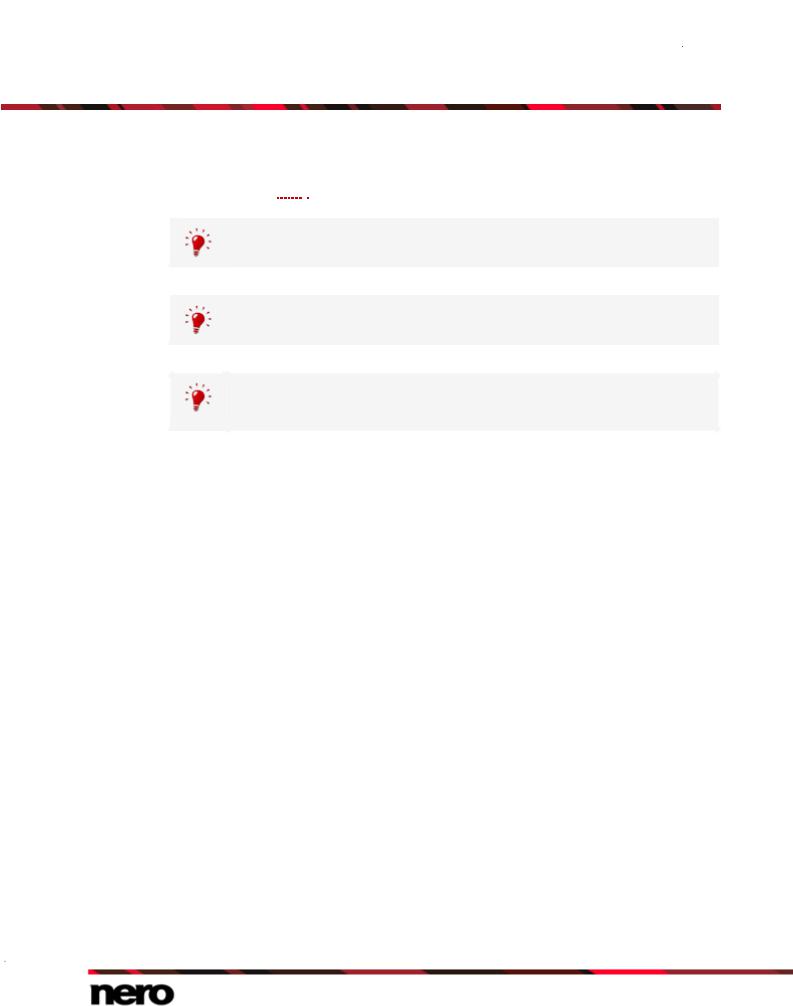
Data Disc
In the ISO tab, in the area Relax Restriction, the restrictions imposed by the selected file system can be relaxed. For example, you can allow a higher path level or more than 64
characters for the Joliet name.
If the disc should be read on all operating systems, select ISO 9660 as the file system and clear all check boxes in the Relax restrictions area.
An advisory message appears on the ISO tab in the Information area if the disc cannot be read on all operating systems.
If the disc is to be used mainly on computers with Microsoft Windows and you want to use lowercase letters and/or foreign language characters for the file names, select ISO 9660 + Joliet as the file system.
The following setting options are available on the ISO tab in the Data and File areas:
|
Selects the mode for the data. Mode 1 and Mode 2/XA are |
|
|
available. Newer drives can easily read Mode 1 and Mode 2/XA |
|
Drop-down menu |
CDs. |
|
Data mode |
However, some older drives cannot read Mode 1 discs correctly. |
|
|
In the case that the disc can to be read in any case on older |
|
|
drives, select the Mode 2/XA format. |
|
|
|
|
|
Selects the file system that is used for the data. |
|
|
ISO 9660 only: ISO format alone is used. |
|
Drop-down menu |
ISO 9660 + Joliet: ISO format is used and is enhanced by the |
|
Joliet standard. |
||
File system |
||
ISO 9660:1999: The latest ISO format update is used. Among |
||
|
||
|
other things it allows the use of 207 characters and a deeper |
|
|
directory depth. |
|
|
|
|
Drop-down menu |
Defines the possible length of the file name. Level 1 and Level |
|
2 are available. In Level 1 the file name can be eight characters |
||
Length of file name |
long and the file name extension (e.g. *.doc) three characters. In |
|
|
Level 2 the file name can be 31 characters long. |
|
|
|
|
Drop-down menu |
Defines the character set used for ISO names. |
|
Character set |
||
|
||
|
|
Nero Burning ROM |
28 |

Data Disc
3.2Compiling a SecurDisc disc
SecurDisc is a technology with which you can create discs with special protection properties. No special hardware is needed.
Discs that are created with Nero Burning ROM and the SecurDisc compilation type include data integrity and reconstruction. Additional SecurDisc features include the possibility to protect the data on your disc against unauthorized access with a password, to digitally sign the disc, and to configure the data redundancy.
To be able to copy the protected data to your hard drive and to check the security of the data you will need a special application named Nero SecurDisc Viewer. The Nero SecurDisc Viewer is burned automatically to the SecurDisc disc and can be downloaded free of charge at www.securdisc.net or www.nero.com.
More information on SecurDisc technology can be found at www.securdisc.net.
To compile a SecurDisc disc, proceed as follows:
1.Select the desired disc format (CD, DVD, Blu-ray) from the drop-down menu in the New
Compilation window. (In the case that the New Compilation window is not opened, it can be opened by clicking the New button on the main screen.)
The selection list shows the compilation types that can be burned.
2.Select the desired compilation type for a SecurDisc from the selection list.
The tabs with the configuration options that are valid for this compilation type are displayed.
Nero Burning ROM |
29 |
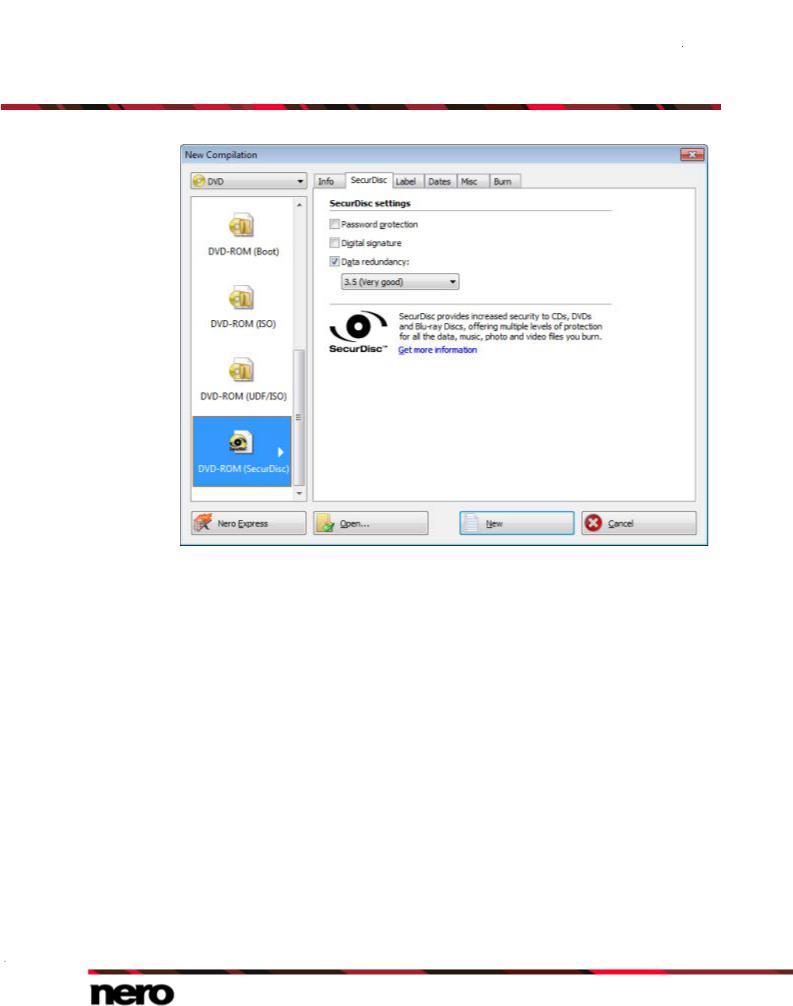
Data Disc
3.If you want to enable the password protection for all files:
1.Enable the Password protection check box on the SecurDisc tab. The SecurDisc – Protect Data window is opened.
Nero Burning ROM
SecurDisc Compilation
30
